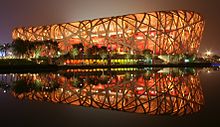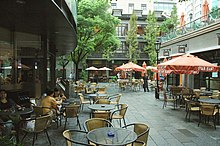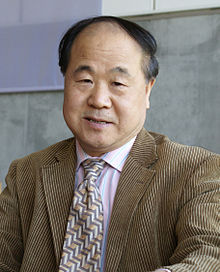|
Postmodernism in China
 Postmodernism (Chinese: 后现代主义; pinyin: hòuxiàndàizhǔyì) emerged in China during the late 20th century as the country underwent rapid economic development and globalization. While influenced by Western postmodern currents, Chinese postmodernism developed distinctively as it interacted with China's unique historical and cultural context. It challenged traditional Chinese aesthetics and philosophies, reinterpreting them through an eclectic postmodern lens. This ushered in experimental forms of expression across literature, art, architecture, intellectualism, and cinema. Chinese artists interwove traditional motifs with postmodern pastiche, irony, and critical engagement with contemporary issues. Postmodernism in China thus represents a fusion of global trends and local heritage. It provides a lens to understand modern China as artists and intellectuals navigate expressing individuality within the nation's socio-political landscape.[1] Historical contextThe emergence of postmodernism in China is not an isolated phenomenon, but a response to the country's rapid transition and its complex interactions with global trends.[1][2] Political landscapeThe political landscape in China during the late 20th century, especially post-Mao era reforms initiated by Deng Xiaoping, set the stage for postmodernist influences. These reforms, marked by the "Reform and Opening Up" in the late 1970s, ushered in an era of economic liberalization and increased exposure to Western ideologies and culture.[2] This period saw a gradual relaxation of strict ideological controls and a move towards a more open and diverse cultural environment. However, this liberalization was not uniform and was often subject to the changing tides of political sentiment, influencing how postmodern ideas were received and expressed.[3] Economic developmentEconomic development, characterized by rapid industrialization and urbanization, profoundly impacted the social fabric and cultural expressions in China. The shift from a predominantly agrarian society to an urban, industrial powerhouse within a few decades created a milieu where traditional values intersected and sometimes clashed with modernist and postmodernist ideas. The economic boom brought about by these reforms led to increased wealth, but also social disparity, challenging long-standing cultural norms and ideals.[4] Social changesThese economic and political shifts were accompanied by significant social changes. The Cultural Revolution (1966-1976) had previously sought to purge bourgeois and traditional elements from Chinese society, creating a vacuum that postmodernism, in part, began to fill.[3][5][6] The post-Cultural Revolution era saw a resurgence of interest in traditional Chinese culture, as well as an openness to Western cultural influences. This period was marked by a questioning of traditional values and an exploration of new forms of cultural and artistic expression.[7] GlobalizationThe impact of globalization during the late 20th and early 21st centuries is crucial context for the development of Chinese postmodernism. The influx of foreign ideas, coupled with China's growing influence on the global stage, created a cross-cultural dialogue that significantly influenced the development of postmodernist thought in China. This exchange led to a unique blend of Eastern and Western philosophies, aesthetics, and cultural practices.[5][8] Cultural revival and critiqueIn the realm of art and literature, this era witnessed a revival of interest in traditional Chinese aesthetics, albeit often approached with a postmodern sensibility that involved both a critique and a celebration of the past. Chinese postmodernism frequently engages in a nuanced re-examination of historical themes, traditional motifs, and classical philosophy, recontextualizing them in the light of contemporary experiences and global influences.[9][8] Themes and characteristicsPostmodernism in China, while drawing from a global movement, exhibits its own unique themes and characteristics, including a nuanced approach to cultural identity, responses to globalization, and the interplay between traditional and modern elements.[10] Reinterpretation of cultural identityA central theme in Chinese postmodernism is the reinterpretation of cultural identity. In the wake of rapid modernization and globalization, Chinese artists and thinkers have grappled with questions of what constitutes Chinese identity.[11] This has often involved a re-examination and deconstruction of traditional Chinese culture, philosophy, and aesthetics. Postmodernist works in China frequently engage with historical narratives, classical literature, and ancient philosophies, reinterpreting them through contemporary lenses.[8] This process is not merely a revival of the past but a critical engagement that challenges and redefines what it means to be Chinese in a modern context. Response to globalizationGlobalization has been a powerful force influencing postmodernism in China. Chinese postmodernists often reflect on the impact of global cultural flows on local traditions and identities. This includes an exploration of how Western cultural norms and practices are assimilated, resisted, or transformed within the Chinese context. The result is often a hybrid cultural expression that blends global and local elements, reflecting the complex dynamics of cultural exchange and influence in an increasingly interconnected world.[12] Blending of traditional and modern elementsThe blending of traditional and modern elements is a hallmark of Chinese postmodernism. In visual arts, literature, architecture, and cinema, there is a visible juxtaposition and fusion of ancient motifs with modernist and postmodernist techniques.[13][9][5] This blending goes beyond mere aesthetic fusion; it often carries a deeper commentary on the tension and harmony between China's rich historical heritage and its contemporary reality. This theme reflects a broader societal dialogue about the place of tradition in a rapidly modernizing country.[14] Irony and parodyIrony and parody are frequently employed in Chinese postmodernist works as tools to question established norms, challenge authority, and comment on the absurdities and contradictions inherent in contemporary life.[15][5] This is particularly significant in a society where direct criticism may be constrained, making irony and parody effective means of subtle dissent and social commentary.[6] Fragmentation and multiplicityConsistent with global postmodernist trends, Chinese postmodernism often embraces fragmentation and multiplicity in narrative and form. This characteristic rejects the idea of a single, unified perspective, instead presenting a world of multiple realities and diverse viewpoints. This approach is reflective of the pluralistic and often chaotic experience of modern life in China, where rapid changes and diverse influences create a complex and multifaceted society.[16] Critique of consumerism and materialismAs China has experienced economic growth and rising consumerism, many postmodernist artists and thinkers have critically engaged with these phenomena. Works often critique the relentless pursuit of material wealth and question the sustainability and ethical implications of consumerist culture. This theme reflects broader concerns about the social and environmental costs of economic development.[12] Areas of influencePostmodernism has permeated various cultural and intellectual domains in China, including literature, art, architecture, philosophy, and cinema.[1] LiteratureChinese postmodern literature is marked by its experimentation with narrative forms and its departure from the socialist realist style predominant in earlier decades. Authors like Mo Yan and Yu Hua are known for their use of magical realism, non-linear storytelling, and metafictional techniques. These narratives often blend historical, fantastical, and contemporary elements, challenging traditional literary conventions and offering new ways of understanding China's past and present. Irony and satire are frequently used to critique social and political issues subtly.[8][13]
ArtIn the realm of visual arts, Chinese postmodernism is characterized by an eclectic mix of styles and mediums. Artists such as Ai Weiwei and Cai Guo-Qiang have gained international acclaim for works that blend traditional Chinese materials and techniques with contemporary conceptual art practices. These artists often engage with themes of cultural identity, globalization, and the tensions between tradition and modernity, using their art to comment on social and political issues in China and beyond.[9]
Architecture Postmodernism in Chinese architecture is visible in the blending of traditional architectural elements with modern design principles. This is evident in projects like the Beijing National Stadium (Bird's Nest) and Shanghai's Xintiandi district, where architects combine historical motifs with innovative, contemporary designs. This approach reflects a desire to create a built environment that is distinctly Chinese yet responsive to the demands of a rapidly urbanizing society.[28]
PhilosophyIn philosophy, Chinese postmodernism is often intertwined with the reinterpretation of traditional Chinese thought, particularly Daoism and Confucianism, through a postmodern lens. Philosophers and theorists engage with these ancient philosophies, drawing parallels with postmodern ideas of multiplicity, relativity, and the rejection of absolute truths. This has led to a unique philosophical discourse that seeks to reconcile traditional Chinese wisdom with contemporary global philosophical trends.[12]
CinemaChinese cinema has also been influenced by postmodernism, with filmmakers employing non-linear narratives, pastiche, and self-referentiality. Directors like Jia Zhangke and Wong Kar-wai are known for their stylistic innovations and exploration of themes such as urban alienation, historical memory, and the impact of globalization on individual lives. Their films often defy conventional storytelling techniques, offering a more fragmented and subjective view of China's rapidly changing society.[35][6]
Comparison with Western postmodernismThe postmodernist movement in China, while sharing the core tenets of skepticism, irony, and the rejection of grand narratives with its Western counterpart, exhibits distinctive characteristics shaped by the country's unique cultural and political landscape. Wang Ning argues for using the terms "postmodern" and "postmodernity" rather than "postmodernism" when discussing postmodernism in the Chinese context. This is to acknowledge the unique manifestation of postmodern elements in China, which differ from their original Western forms.[10] SimilaritiesBoth Western and Chinese postmodernism question the objective knowledge claims and universal truths that were often upheld by modernist thinkers.[37] They share a predilection for fragmentation, pastiche, and a bricolage of styles and mediums. In literature and art, there is a shared tendency to disrupt traditional narrative structures and to embrace paradox and ambiguity.[13] Both movements also respond to the conditions of late capitalism, though the specifics of this engagement may differ due to the distinct socio-economic conditions in China as opposed to the West.[38][10] DifferencesCultural and ideological foundationsChinese postmodernism is deeply rooted in the nation's extensive philosophical and cultural heritage. It often reimagines traditional Chinese ideologies and aesthetics through a postmodern lens, whereas Western postmodernism tends to be more focused on critiquing the Western canon and history.[38][10] Political contextThe political environment in China has significantly influenced the development and expression of postmodernism. Chinese postmodernists often navigate more restrictive political conditions, which impact the themes and modes of expression in their work.[39] In contrast, Western postmodernism has generally developed in a context with fewer constraints on freedom of expression.[1] Economic developmentThe rapid economic development and urbanization of China provide a different backdrop for the emergence of postmodernism compared to the West. Chinese postmodernist works frequently engage with the dislocations and cultural shifts brought about by this swift transformation, reflecting on the loss of tradition and the rise of consumer culture in a way that is specific to the Chinese experience.[35][40] GlobalizationWhile both Western and Chinese postmodernists grapple with the effects of globalization, the perspective in China is colored by the nation’s transition from a closed society to a major actor on the global stage. This gives Chinese postmodernism a dual focus on asserting a distinct cultural identity while also engaging with global cultures.[39] Artistic expressionIn the arts, Chinese postmodernism often employs irony and metaphor in a more subdued manner, reflecting a need to balance critique with the nuances of political acceptability.[5] Western postmodernism, with its tradition of direct satire and parody, frequently engages in more overt social and political criticism. Criticism and receptionThe reception of postmodernism in China, both domestically and internationally, has been varied and multifaceted, reflecting the complex nature of the movement itself. Critiques have emerged from a range of perspectives, engaging with the theoretical foundations, cultural implications, and socio-political context of postmodernism in China.[10] Domestic criticismWithin China, postmodernism has been both celebrated for its innovative approach to culture and criticized for its perceived detachment from social realities. Some Chinese critics argue that postmodernism, with its Western origins, is an imported concept that may not fully resonate with Chinese society or address its specific concerns. It has been seen by some as a form of cultural elitism, disconnected from the lived experiences of the majority of the population.[10] Additionally, the movement's tendency to question and deconstruct historical narratives and traditional values has sparked debate about cultural preservation and national identity in the face of rapid modernization.[3][15] International receptionInternationally, Chinese postmodernism has been recognized for its unique contribution to global cultural discourse, offering alternative perspectives and practices that challenge Western hegemony in art and literature. However, it has also faced scrutiny over the extent to which it genuinely reflects postmodernist ideals, with some critics suggesting that the movement in China is more a product of economic and political conditions than a true philosophical or aesthetic shift.[10] Concerns have also been raised about the authenticity and originality of Chinese postmodernist works, with accusations of mimicry or superficial adoption of Western styles.[11][10] Theoretical critiquesTheoretically, postmodernism in China has been critiqued for its perceived relativism and skepticism, which some argue can lead to political apathy or cynicism. Critics from more traditional or Marxist perspectives have expressed concerns that postmodernism could undermine efforts to address inequality and promote social justice, instead fostering a sense of fragmentation and disengagement from collective action.[14][3] Artistic and cultural critiquesFrom an artistic standpoint, postmodernism in China has been both lauded for its creative reimagining of traditional forms and questioned for its commercialization and commodification of culture. The movement's flirtation with consumer culture and mass media has led to accusations of contributing to the very materialist values it often seeks to critique. In the realm of literature and cinema, while some praise the innovative narratives and styles, others decry a loss of depth and meaning in pursuit of stylistic novelty.[9][8][35][10] BibliographyBooks
Articles and book chapters
References
External links
Information related to Postmodernism in China |


